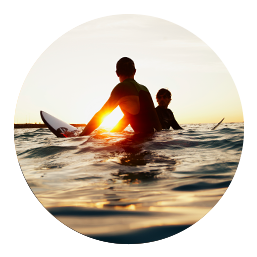 Shark activity map
Shark activity map
Switch on your Sea Sense.
Read more
Latest shark advice and warnings.
Read More










Frequently Asked Questions
Why are BEN signs important?
Each BEN sign has a unique code linked to the coordinates for the location of the sign.
The signs provide specific location information, vital when emergency services are deployed in the event of an emergency.
When visiting the coast, take note of your closest BEN sign.
What do BEN signs look like?
All BEN signs installed under the state government’s program are reversible with a uniform red and green sign on the front and a beach or area closure alert on the back.
This consistent approach is helping ensure familiarity, which improves sign awareness in an emergency.
Where are BEN signs located?
There are more than 1,800 BEN signs installed along the Western Australian coast. Signs can be seen on coastal paths and beach access points, harbours, estuaries, rivers, boat ramps and fishing platforms.
Sign locations are determined by the land manager in consultation with DPIRD and relevant stakeholders.
BEN sign locations can be viewed on the SharkSmart activity map.
How do I use a BEN sign in an emergency?
Your closest BEN sign number and location information can also be found in the SharkSmart WA app in the ‘Report’ section, along with a quick call link to dial 000.
In an emergency, dial 000 and quote the unique code and location information. Where possible, someone should wait at the BEN sign until emergency services arrive.
When visiting the beach, you can also take a photo of your closest BEN sign on your phone!
How do I use a BEN sign when reporting a shark sighting?
BEN signs may be referred to when reporting a shark sighting to Water Police on 9442 8600. This helps implement beach closures earlier, using accurate location information.
What if there is no BEN sign?
In an emergency where there is no BEN sign, you are encouraged to use the Emergency+ app.
The app uses the GPS functionality built into smart phones to help a triple zero caller provide critical location details required to mobilise emergency services.
The Emergency+ app can be download from the App Store and Google Play.
What if there is no mobile phone coverage?
Where mobile phone communication coverage is limited, emergency calls can sometimes still be made on triple zero by using another mobile service provider available in the area.
When visiting areas where no mobile coverage is available, you should monitor mobile phone signal strength and seek high points in the landscape to aid communication.
How are beach emergency numbers allocated?
Each BEN sign has a unique code based on an area prefix followed by a 1– 4 digit number. BEN prefixes are consistent with the DTMI system for vehicle number plates.
Numbers are not sequential but are based on the distance between the sign’s location and the LGA’s northern or western boundary — for example, WR101 refers to the Shire of Waroona, approximately 10.1 km from its northern boundary.
These codes are linked to the coordinates for the sign’s location. The official location name (if there is one), the address, suburb and nearest intersection are also on each sign. This information is integrated into computer aided dispatch systems used by emergency services (ambulance, police and fire crews).
How are the addresses devised?
The addresses may refer to nearby house numbers and streets, such as ‘Opposite 79 Mitchell Rd’. Where there are no houses, addresses refer to distances and bearings from known locations. For example, 1.5 km west of the Marine Drive and Thomas St intersection.
My local BEN sign is missing or damaged. What should I do?
If your local BEN sign is missing or damaged, you should contact the land manager, such as the LGA, who will organise replacement or repair. If the BEN sign is located within a national park, you can contact the local DBCA office.
Not sure who to contact… take an image of the damaged sign or pole (if the sign is missing), take note of your location (such as street address and any land marks which may help describe the location) and email the details to sharksmart@dpird.wa.gov.au. The BEN sign coordinator will pass the information onto the relevant land manager.
Did you know… when taking the image, make sure you enable your location services on your device and allow your camera to access your location. This means that the location coordinates can be automatically embedded into the photo, making it easier to determine what BEN sign is missing.
Where did the initiative of BEN signs come from?
BEN signs were the initiative of Rick Gerring, brother of Ben Gerring who lost his life after a shark bite incident at Gearys Surf Break, Mandurah in 2016.
Mr Gerring put forward the idea following concerns that emergency services had difficulties locating the closest beach access point when responding to the incident.
BEN signs were initially implemented by the City of Mandurah who installed 81 BEN signs along the coast. With the support of the state government grants program, there are now over 150 signs installed in the Mandurah area, and over 1,800 signs around the state.
I would like to arrange installation of a BEN sign at a new coastal land development or dangerous location. What should I do?
Contact the relevant land manager such as the LGA, or if the proposed sign is located within a national park, contact the local DBCA office, to discuss the location and why a BEN sign should be installed.
Not sure who to contact… email sharksmart@dpird.wa.gov.au. In your email include the location of the proposed BEN sign and reasons why it should be installed at the location. The BEN sign coordinator will discuss your suggestion with the relevant land manager.
How are BEN signs funded?
In December 2017, the state government launched a grants program to provide funding for LGAs to install BEN signs along the coast from Geraldton to the South Australian border. The grants program was extended in December 2020 to include coastal LGAs north of Geraldton to Kununurra, making the program accessible statewide.
The grants program has been developed and coordinated by DPIRD which has also provided support to LGAs in the development of their grant applications.
For further information contact your LGA or email sharksmart@dpird.wa.gov.au
Back to Beach Emergency Numbers